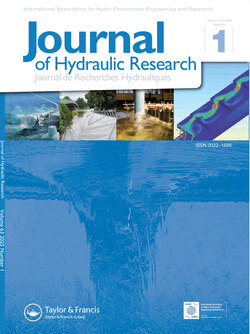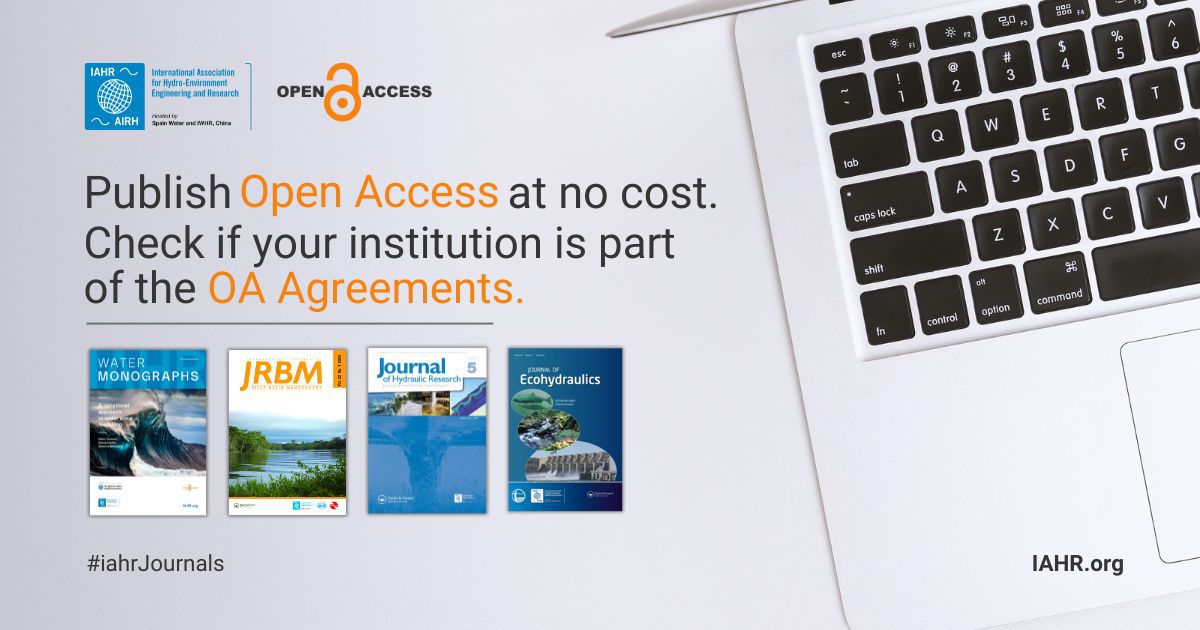Journal of Hydraulic Research Vol. 63, Issue 1, 2025 is launched!
 The Journal of Hydraulic Research (JHR) publishes research papers in theoretical, experimental and computational hydraulics and fluid mechanics, relating to rivers, lakes, estuaries, coasts, constructed waterways, and some internal flows such as pipe flows. To reflect current trends in water research, articles that explore outcomes of interdisciplinary hydro-environment studies with a strong fluid mechanical component are especially welcome. Although preference is given to fundamental issues, papers focusing on important unconventional or emerging applications of broad interest are also appreciated.
The Journal of Hydraulic Research (JHR) publishes research papers in theoretical, experimental and computational hydraulics and fluid mechanics, relating to rivers, lakes, estuaries, coasts, constructed waterways, and some internal flows such as pipe flows. To reflect current trends in water research, articles that explore outcomes of interdisciplinary hydro-environment studies with a strong fluid mechanical component are especially welcome. Although preference is given to fundamental issues, papers focusing on important unconventional or emerging applications of broad interest are also appreciated.
Overview
The first issue of the Journal of Hydraulic Research for 2025 includes 10 contributions; seven research papers, two technical notes and one book review. The authors employ theoretical, experimental and computational tools to advance the current state-of-knowledge on subjects of importance to researchers and practitioners alike. In the first paper, the behavior of supercritical free surface flows around cylindrical obstacles is examined by solving numerically the unsteady RANS equations. The objective of the next paper is to determine the optimum height range of bank-attached vanes, scaled by bankfull depth, for minimizing bank erosion at river bends. Detailed laboratory experiments are used in the third paper to investigate the role of a labyrinth weir as a flow aerator in a stepped spillway. The fourth paper presents an aggregate numerical model for simulating river-reservoir dynamics, capable of substantially improving computational efficiency without sacrificing accuracy. In the fifth paper, the authors develop a 1D hydraulic and sediment transport numerical model for simulating the long-term spatiotemporal evolution of a single iron-ore tailings pulse released in the Paraopeba River. The following contribution is using numerical simulations describing the interaction among sediment, water flow and stream habitat to determine suitable operations of cascaded hydropower stations that will enhance the quality of fish spawning grounds in the upper Yellow River. In the last research paper, the authors perform large eddy simulations of an open-channel flow to identify the effects of U-burrow density and bioirrigation intensity on near bed turbulence characteristics. The authors of the first technical note , propose a new vertical slot fishway design that provides a better passage for migrating fish under fluctuating water-level conditions in a reservoir. In the second technical note, the authors use a fluid–structure interaction model, as well as experimental data with human subjects, to investigate the various factors affecting the stability of individuals in floodwaters and provide strategies in terms of body posture for enhancing it. This JHR issue concludes with a review of a recently published book on fluvial hydrodynamics and sediment transport.
IAHR members can access the latest issue online.
Non IAHR members must access through Taylor & Francis website.
Research Papers
RANS simulation of supercritical open channel flows around obstacles
Bastián Martínez, Maricarmen Guerra, Nicolas Riviere, Emmanuel Mignot and Oscar Link
Pages: 1-14 | DOI: 10.1080/00221686.2024.2446570
A laboratory-scale numerical study of the effects of bank-attached vane submergence on flow pattern and bed shear stress distribution
Mohammad Bahrami-Yarahmadi, Roya Erick, Mahmood Shafai-Bejestan and Erik Mosselman
Pages: 15-31 | DOI: 10.1080/00221686.2024.2446582
Enhancing flow aeration on an embankment sloped stepped spillway using a labyrinth weir
Megh Raj KC, Brian Crookston, Kade Flake and Stefan Felder
Pages: 32-47 | DOI: 10.1080/00221686.2024.2448238
Flood-control reservoir simulation using an aggregated model and regulation in 2D shallow water problems
Pablo Vallés, Isabel Echeverribar and Pilar García-Navarro
Pages: 48-63 | DOI: 10.1080/00221686.2024.2445539
Spatiotemporal evolution of mine tailings released in sand-bed rivers
Andrés F. Rojas-Aguirre and Marcelo H. Garcia
Pages: 64-87 | DOI: 10.1080/00221686.2024.2446567
Influences of the associated operation on fish spawning ground in the upper Yellow River under cascaded hydropower stations considering sediment factors
Lu Yang, Jingming Hou, Pan Wang, Ce Song and Xujun Gao
Pages: 88-101 | DOI: 10.1080/00221686.2024.2437544
Effects of U-burrow bioirrigation on turbulence characteristics
Zonghong Chen, Guojian He, Yan Liu, Lei Huang and Subhasish Dey
Pages: 102-116 | DOI: 10.1080/00221686.2024.2448735
Technical Note
Vertical slot fishway design for fluctuating water-level reservoir
Tiegang Zheng, Chengyi Tu, Zhiguang Zhang, Shuangke Sun, Huichao Dai, Guangning Li and Haitao Liu
Pages: 117-125 | DOI: 10.1080/00221686.2024.2436917
Analysis and improvement of human stability in floodwaters through numerical simulation with SPH-DEM model
Lifang Zhang and Jianmin Zhang
Pages: 126-137 | DOI: 10.1080/00221686.2024.2447110
Book Review
Fluvial hydrodynamics: hydrodynamic and sediment transport phenomena
by Subhasish Dey, Springer, Cham, Switzerland, GeoPlanet: Earth and Planetary Sciences Series, 2024, 893 pp., €219.99, ISBN 978-3-031-26037-7 (hardback), €188.31, ISBN 978-3-031-26038-4 (eBook)
Luca Solari
Pages: 138-139 | DOI: 10.1080/00221686.2025.2450688

